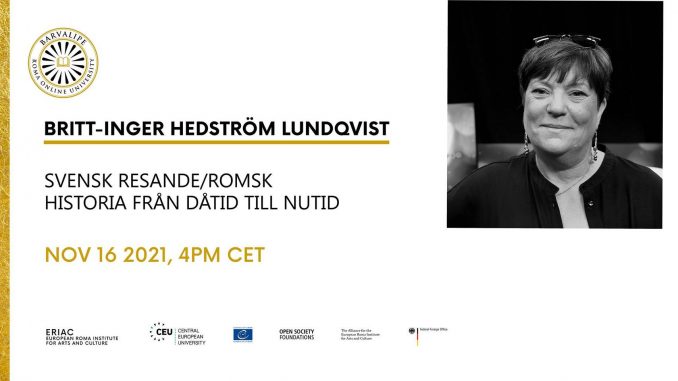
Evenemang av European Roma Institute for Arts and Culture – ERIAC tisdagen den 16 november 2021 kl 16.00 ett offentlig för alla på och utanför Facebook
Facebookevenemang paneldiskussionen förs på svenska.
Svensk resande/romsk historia från dåtid till nutid
Britt-Inger Hedström Lundqvist will deliver a lecture on Swedish Traveller/Roma history, from past to present / Svensk Resande/Romsk historia från dåtid till nutidJoin us for the lecture followed by a discussion with the lecturer and invited guests.The lecture will be in Swedish with English subtitles, the discussion will be in Swedish.
The panelists of the discussion:
Lawen Mohtadi
Dr. Jan Selling
Fred Taikon
Robert Brisenstam
Moderator: Linda Lundqvist
Audience members may join the webinar via the Zoom link below or via Facebook Live on the ERIAC page.
For more information about the Barvalipe Roma Online University please visit the ERIAC webpage where you can also find a complete schedule for the second course of the Barvalipe online lecture series together with the lectures from last year’s first course.
https://eriac.org/barvalipe-roma-online-university/
Zoom Link: https://us02web.zoom.us/j/83972745725
Lecture Abstract in Swedish:
Historia handlar inte bara om det som hänt utan också om vad man vill dölja och vad man vill lyfta fram. Den som skriver historia väljer själv hur en händelse beskrivs. Historieskrivaren beskriver historia ur sitt eget perspektiv och bestämmer vem som är ond eller god, ren eller smutsig, ärlig eller oärlig. Ni ska nu få lyssna på min korta beskrivning av historien om Romanifolken och den antiziganism som har funnits och finns i Sverige och Europa.
De första svenska noteringarna finns i Stockholm stads Tänkebok den 29 september 1512. I boken står det om en okänd folkgrupp med främmande utseende som har annorlunda seder och ett obegripligt språk som har kommit in i landet. De är ett 30-tal familjer som slagit sig ner i staden. Reformatorn Olaus Petri omnämner dem samma år som ”tatare”, kanske för att han trodde att de tillhörde det ryska folket Tatarer. Gruppen omnämns i tänkeboken som ”egyptier” och likställs med pilgrimer. Pilgrimer skulle under denna tidsperioden respekteras, så de fick allmosor och tak över huvudet helt enligt de normer som gällde för mottagandet av främlingar. Dessa människor anses idag vara den första immigrationen av Romanifolk till Sverige och Norden.
Romanifolken utsätts under hela 1900-talet för diskriminering och antiziganism. De utreds, inventerades, registrerades och stigmatiserades allt mer till följd av detta. Romanifolk sågs som ett hot mot folkhemmet och den rationella och moderna människan som skulle växa fram i Sverige. Romanifolkens traditionella levnadssätt och starka familjekänsla passade inte in det nya rena Sverige.
År 2000 bekräftas det att minoriteten romer/resande består av fem grupper, Resandefolket, svenska Romer, finska Romer, utomnordiska Romer och nyanlända Romer. Romanifolken i Sverige lever både i nutiden och i historien. I berättelsen om Romanifolken i Sverige finns övergrepp och ett utanförskap där majoritetssamhället och de som haft makt på många sätt brustit och inte velat ta ansvar. Men det är också en berättelse om stark gemenskap inom gruppen där släktbanden är viktiga. Det finns även berättelser om vänskap, gemenskap och mänsklighet hos majoritetsbefolkningen och vi fortsätter att hela tiden att skriva vår historia.
Lecture Abstract in English
History does not only tell us what happened, it is also about what is hidden and what is highlighted. The one who writes history chooses how an event is described. The storyteller writes history from their own perspective and decides who is bad or good, pure or dirty, honest and dishonest. You are now about to listen to my short description of the history of the Romani people and the antiziganism that was and still is existing in Sweden and Europe.
The first Swedish notes on this matter are written in the Stockholm Annals on September 29th 1512. In the book there is talk about a strange community of people with foreign looks, strange ways and an incomprehensible language who has entered the country. There are 30 something families who set up camp in the city. The reformer Olaus Petri refers to them the same year as ‘tatare’, perhaps thinking they belonged to the Russian Tater people. The group is described in the Annals as ‘Egyptians’ and given pilgrim status. Pilgrims were to be respected so they were given alms and roof over their heads, all according to the rules regarding the welcoming of strangers. These people are viewed today as the first Roma immigrants in Sweden and the Nordic countries.
The Romani people are met with discrimination and antiziganism throughout the 20th century. They are investigated, categorized, registered and stigmatized because of this. Romani people were seen as a threat to the welfare state and the rational and modern man that were to emerge in Sweden. The Roma traditional way of living and strong family values did not fit the idea of the new and neat Sweden.
In the year 2000 it is recognized that the Roma/Traveller minority consists of five groups: the Traveller people, the Swedish Roma, the Finnish Roma, the non-Nordic Roma and the newly arrived Roma. The Romani people of Sweden exists both in the present and in the past. In the story of the Romani people of Sweden there is abuse and alienation where the majority and those in power failed in many ways and did not take responsibility. But it is also a story of a strong community within the group and of the importance of family. There are also stories of friendship, kinship and kindness in the majority population and we are keeping on writing our history.




